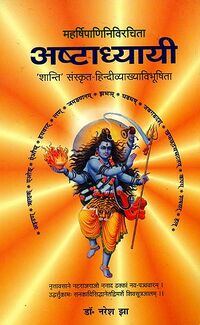Ashtadhyayi
Ashtadhyayi (अष्टाध्यायी) is the foundational text of the grammatical branch of the Vedanga, the auxiliary scholarly disciplines of Vedic religion. Aṣṭādhyāyī means "eight chapters". The Ashtadhyayi is one of the earliest known grammars of Sanskrit by Panini, a Sanskrit grammarian and logician.
Contents
Variants of name
The earliest known grammar
The Ashtadhyayi is one of the earliest known grammars of Sanskrit, although Panini refers to previous texts like the Unadisutra, Dhatupatha, and Ganapatha. It is the earliest known work on descriptive linguistics, and together with the work of his immediate predecessors (Nirukta, Nighantu, Pratishakyas) stands at the beginning of the history of linguistics itself. His theory of morphological analysis was more advanced than any equivalent Western theory before the mid 20th century, and his analysis of noun compounds still forms the basis of modern linguistic theories of compounding, which have borrowed Sanskrit terms such as bahuvrihi and dvandva.
अष्टाध्यायी
- पाणिनि रचित संस्कृत व्याकरण का प्रसिद्ध ग्रन्थ ।
- इसमें आठ अध्याय हैं ।
- इसका भारतीय भाषाओं पर बहुत बड़ा प्रभाव है । साथ ही इसमें यथेष्ट इतिहास विषयक सामग्री भी उपलब्ध है ।
- वैदिक भाषा को ज्ञेय , विश्वस्त, बोधगम्य एवं सुन्दर बनाने की परम्परा में पाणिनी अग्रणी हैं ।
- संस्कृत भाषा का तो यह ग्रन्थ आधार ही है । उनके समय तक संस्कृत भाषा में कई परिवर्त्तन हुए थे, किन्तु अष्टाध्यायी के प्रणयन से संस्कृत भाषा में स्थिरता आ गयी तथा यह प्राय: अपरिवर्त्तनशील बन गयी ।
- अष्टाध्यायी में कुल सूत्रों की संख्या 3996 है । इसमें सन्धि, सुबन्त, कृदन्त, उणादि, आख्यात, निपात,उपसंख्यान, स्वरविधि, शिक्षा और तद्धित आदि विषयों का विचार है ।
- अष्टाध्यायी के पारिभाषिक शब्दों में ऐसे अनेक शब्द हैं जो पाणिनि के अपने बनाये हैं और बहुत से ऐसे शब्द हैं जो पूर्वकाल से प्रचलित थे ।
- पाणिनि ने अपने रचे शब्दों की व्याख्या की है और पहले के अनेक पारिभाषिक शब्दों की भी नयी व्याख्या करके उनके अर्थ और प्रयोग का विकास किया है । आरम्भ में उन्होंने चतुर्दश सूत्र दिये हैं । इन्हीं सूत्रों के आधार पर प्रत्याहार बनाये गये हैं, जिनका प्रयोग आदि से अन्त तक पाणिनि ने अपने सूत्रों में किया है । प्रत्याहारों से सूत्रों की रचना में अति लाघव आ गया है ।
- गणसमूह भी इनका अपना ही है । सूत्रों से ही यह भी पता चलता है कि पाणिनि के समय में पूर्व-अंचल और उत्तर-अंचलवासी दो श्रेणी वैयाकरणों की थीं जो पाणिनि की मण्डली से अतिरिक्त रही होंगी ।
- पाणिनि कृत अष्टाध्यायी वैसे तो व्याकरण का ग्रंथ माने जाते हैं किन्तु इन गंथों में कहीं-कहीं राजाओं-महाराजाओं एवं जनतंत्रों के घटनाचक्र का विवरण भी मिलता हैं।[1]
Jats in Aṣṭādhyāyī
The famed Sanskrit grammarian, Panini (पाणिनि) mentioned about the Jats in this classic-work, namely, Aṣṭādhyāyī, in the form of shloka as " जट झट सङ्घाते " (Jat Jhat Sanghate). And, this shloka highlights that the terms 'Jat' and 'democratic federation' are synonymous. Perhaps, this is the first reference in literature directly referring to the community known as the 'JATS'.
Bhim Singh Dahiya[2] writes ...Ashtadhyayi - J .F. Hewitt defines the word, 'Gut', as meaning 'bull', and opines that these people, the Guti, "were the first conquering swarm of the great building race of the Goths, the Getes of Herodotus and the Jats of India".[3] The Age of Nandas and Mauryas gives a non-Aryan word of unknown origin, as 'Ghota' meaning 'horse'. Except its connection with horse, the origin and etymology of this word is not clear. But Ashtadhyayi (5th century B.C.) gives a root (परस्मैपदीधातु ) under Bhavadigana, as "Jaṭta Jhaṭta Sanghāteh" (जट झट संघाते:), meaning that the word Jaṭ/Jhaṭ is used for a federal Union or Sangha (league). Therefore, the federation or league of various clans, into or by which, the scattered forces are united, is called Jat.
Jata Jhat Sanghate
jaT(a) [ जट ] — सङ्घाते (Saṅghāte) IAST: Jaṭa Saṅghāte
See on the site - http://sanskrit.sai.uni-heidelberg.d.../i_jaTa_a.html
jhaT(a) [ झट ] — सङ्घाते (Saṅghāte) IAST: Jhaṭa Saṅghāte
http://sanskrit.sai.uni-heidelberg.d...i_jhaTa_a.html
||स्वरांकित पाणिनीयधातुपाठः ||
||अथ पाणिनीयधातुपाठः||
अथ भ्वादयः |
१. १ भू सत्तायाम् | उदात्तः परस्मैभाषः ||
अथ टवर्गीयान्ताः | Meaning words ending with 't'
३४२ जटऽ
३४३ झट सङ्घाते
URL address is - http://sanskritdocuments.org/all_sa/...atha_unic.html
||पाणिनीयधातुपाठः सूची स्वरविरहित ||
||अथ धातुपाठसूची ||
जट् | भ्वा० सेट् प० | जट- [सङ्घाते]१. ३४२ ||
झट् | भ्वा० सेट् प० | झट सङ्घाते १. ३४३ ||
URL address is - http://sanskritdocuments.org/all_sa/...ndex_unic.html
Meaning of Jata jhata sanghate is that jata and jhata dhatus are used for sangha
जट झट संघाते
व्याकरण के विद्वान पाणिनि का जन्म ई. पूर्व आठवीं शताब्दी में प्राचीन गंधार राज्य के सालतुरा गाँव में हुआ था, जो इस समय अफगानिस्तान में है, उन्होंने अष्टाध्यायी व्याकरण में 'जट' धातु का प्रयोग कर जट झट संघाते सूत्र बना दिया. इससे इस बात की पुष्टि होती है कि जाट शब्द का निर्माण ईशा पूर्व आठवीं शदी में हो चुका था. पाणिनि रचित अष्टाध्यायी व्याकरण का अध्याय 3 पाद 3 सूत्र 19 देखें: 3. 3. 19 अकर्तरि च कारके संज्ञायां । अकर्तरि च कारके संज्ञायां से जट् धातु से संज्ञा में घ ञ् प्रत्यय होता है. जट् + घ ञ् और घ ञ प्रत्यय के घ् और ञ् की इति संज्ञा होकर लोप हो जाता है. अ रह जाता है अर्थात जट् + अ ऐसा रूप होता है. फ़िर अष्टाध्यायी के अध्याय 7 पाद 2 सूत्र 116 - 7. 2. 116 अतः उपधायाः से उपधा अर्थात जट में के ज अक्षर के अ के स्थान पर वृद्धि अथवा दीर्घ हो जाता है. जाट् + अ = जाट[4]
External links
- अष्टाध्यायी - शब्दानुक्रमणिका (Ashtadhyayi - Word Index)
- http://en.wikipedia.org/wiki/Astadhyayi
- अष्टाध्यायी - PDF फॉर्मेट में डाउनलोड करें
References
- ↑ http://bharatdiscovery.org/india/अष्टाध्यायी
- ↑ Jats the Ancient Rulers (A clan study)/The Jats,p. 16
- ↑ J. F. Hewitt, op. cit., p. XXIX.
- ↑ डॉ महेन्द्रसिंह आर्य, धर्मपाल डूडी, किसनसिंह फौजदार, डॉ विजेन्द्रसिंह नरवार:आधुनिक जाट इतिहास, 1998,, पृ. 1
